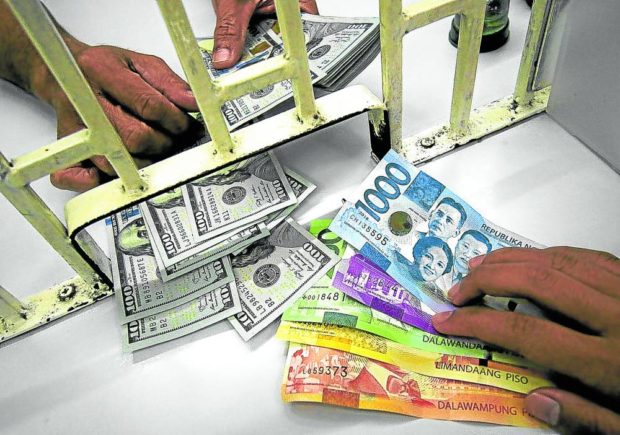No end in sight for peso weakness, hits new low against US dollar
MANILA, Philippines — The Philippine peso wilted to a new record low against the US dollar for the second consecutive trading day, closing at 56.999:$1 on Monday.
Also another new record, the peso touched 57:$1 at its numeric high—but weakest in terms of value—during intraday trading as the latest hawkish statements from the United States Federal Reserve that hinted at further interest rate hikes re-echoed across the international financial markets.
The local currency opened spot trading at 56.85:$1 and registered at 56.8:$1 at its best stance for the day.
The intraday “low” or strongest position was even weaker than the 56.77:$1 closing on Sept. 2.
Rizal Commercial Banking Corp. chief economist Michael Ricafort said the peso was trading weaker against the greenback for the third straight day.
Article continues after this advertisementMonday‘s decline
On Monday, the peso lost 22.9 centavos or 0.4 percent of its value to the dollar as the American currency traded generally stronger against other major global currencies.
Article continues after this advertisementRicafort noted that US Fed officials in a symposium on Aug. 26 signaled higher policy rates for a longer period in an effort to bring down elevated inflation that have reached their highest levels in four decades in the world’s largest economy.
Inflation in the United States in July was 8.5 percent and appeared to have peaked at 9.1 percent a month earlier in June.
Further, Ricafort said the peso was also weaker given the new record high outstanding national debt, which the Bureau of the Treasury said reached P12.89 trillion at the end of July.
On the other hand, the economist said the pressures undermining the peso were partially offset by receding prices of crude oil, which were hovering at near seven-month lows.
Energy prices
Luis Limlingan, managing director of Regina Capital Development Corp., said Brent crude futures—the de facto global benchmark—closed at $93.02 per barrel while the American benchmark WTI crude futures was at $86.87 per barrel.
Ricafort said the latest prices have already erased all the increase since the Russia-Ukraine war started on Feb. 24.
This “could lead to a possible easing of the Philippine trade deficit and could somewhat help ease inflationary pressures and headline inflation for the coming months,” he added.
